This asparagus quiche recipe highlights spring’s favorite vegetable with Dijon mustard and fresh herbs. To keep it on the healthier side, I swapped heavy cream with milk and used nutty whole wheat flour in the crust.
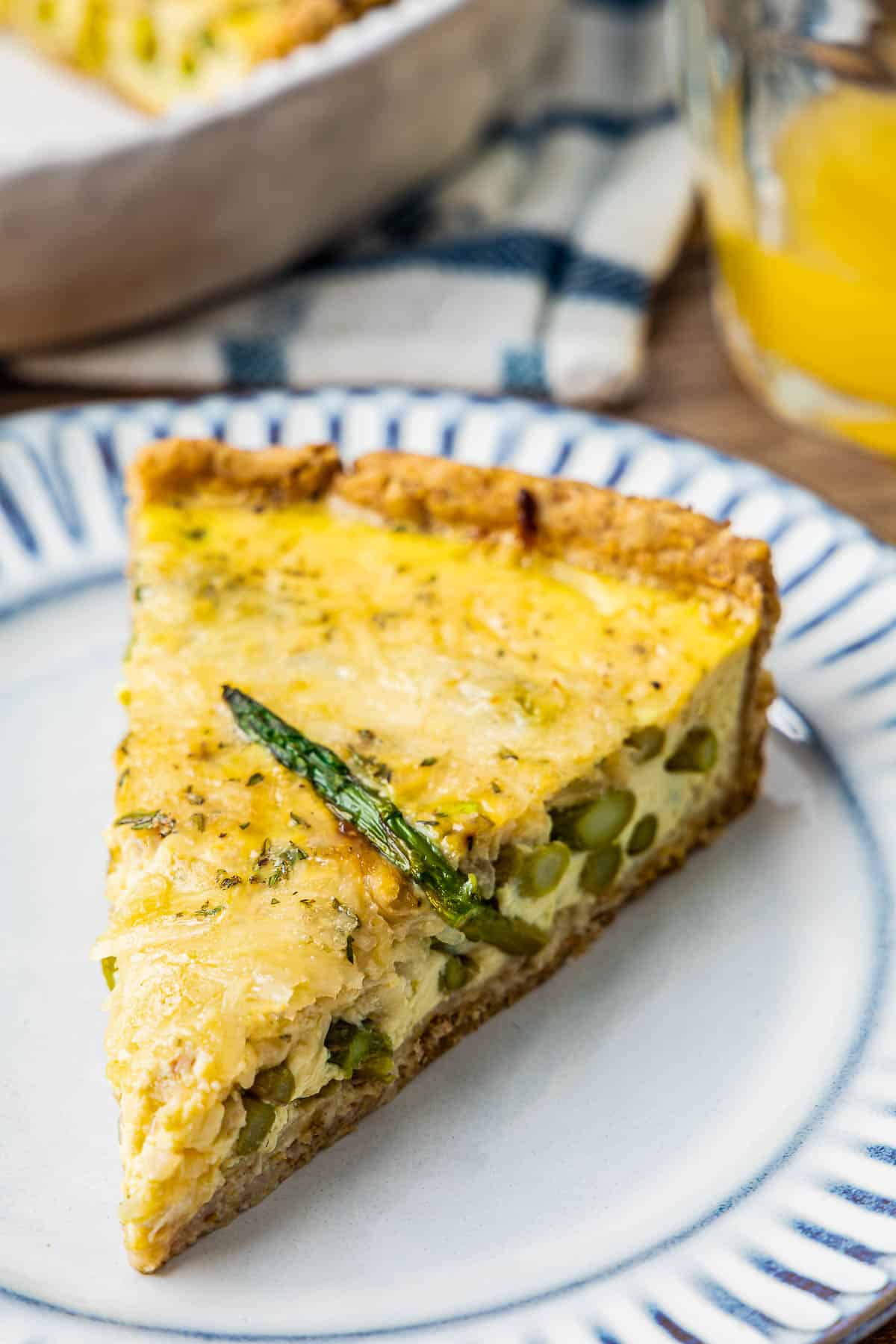
Asparagus quiche is an exceptional dish in that it transcends time. It works just as well for brunch on a special morning as it does for a light dinner or weekday lunch. In addition to tasting delicious, quiche is easy to pair with something light like this Summer Berry Salad or Mediterranean Cucumber Tomato Salad. Or, serve with something more substantial like Crispy Roasted Potatoes.
When developing this recipe, I knew I wanted to showcase the best of spring and summer flavors while supporting my health and well being with nutritious ingredients. To do this, I briefly saute fresh asparagus with onions and garlic, then enhance the egg filling with pungent Dijon mustard and Asiago cheese for a savory and exciting flavor combination. While a fragrant smattering of fresh herbs, like thyme or tarragon brings freshness.
To wrap things up, I then bake all of those beautiful ingredients in a whole wheat crust, which lends an earthy slightly nutty flavor that enhances the entire dish. When thinking about Mother’s Day, Easter or just a simple brunch, quiche is always at the top of my list.
Asparagus Quiche to Celebrate Spring
In my family, we serve quiche on special occasions. I have fond memories of all kinds of wonderful quiches, from family brunches to coastal cafés with scratched marble tables, filled with everything from spinach and tomatoes to locally-caught lobster.
When I lived in Spain, the arrival of spring was marked by asparagus popping up on menus everywhere. It took center stage at the vegetable stalls in the markets, which is why asparagus quiche is an all time favorite recipe for me especially in the spring when the tender green stalks are at their best.
There’s a frenzied rush to celebrate asparagus before its season ends. During these fleeting, magical months, my favorite combination was always asparagus with eggs. Revuelto (Spanish scrambled eggs), Spanish tortilla, or quiche are some of my go-tos.
This asparagus quiche is unlike your typical, overly heavy quiche loaded with a butter-filled crust, heavy cream and other weighty ingredients like bacon. Early on my career, the first chef I worked for taught me that food doesn’t need to be heavy with fat to taste good. Simultaneously, a lighter take on a classic should never compromise on flavor.
With those ideals in mind, this healthier version of asparagus quiche expertly balances sweet, sharp, and savory flavors without feeling heavy. It may make richer quiches seem almost one-note!
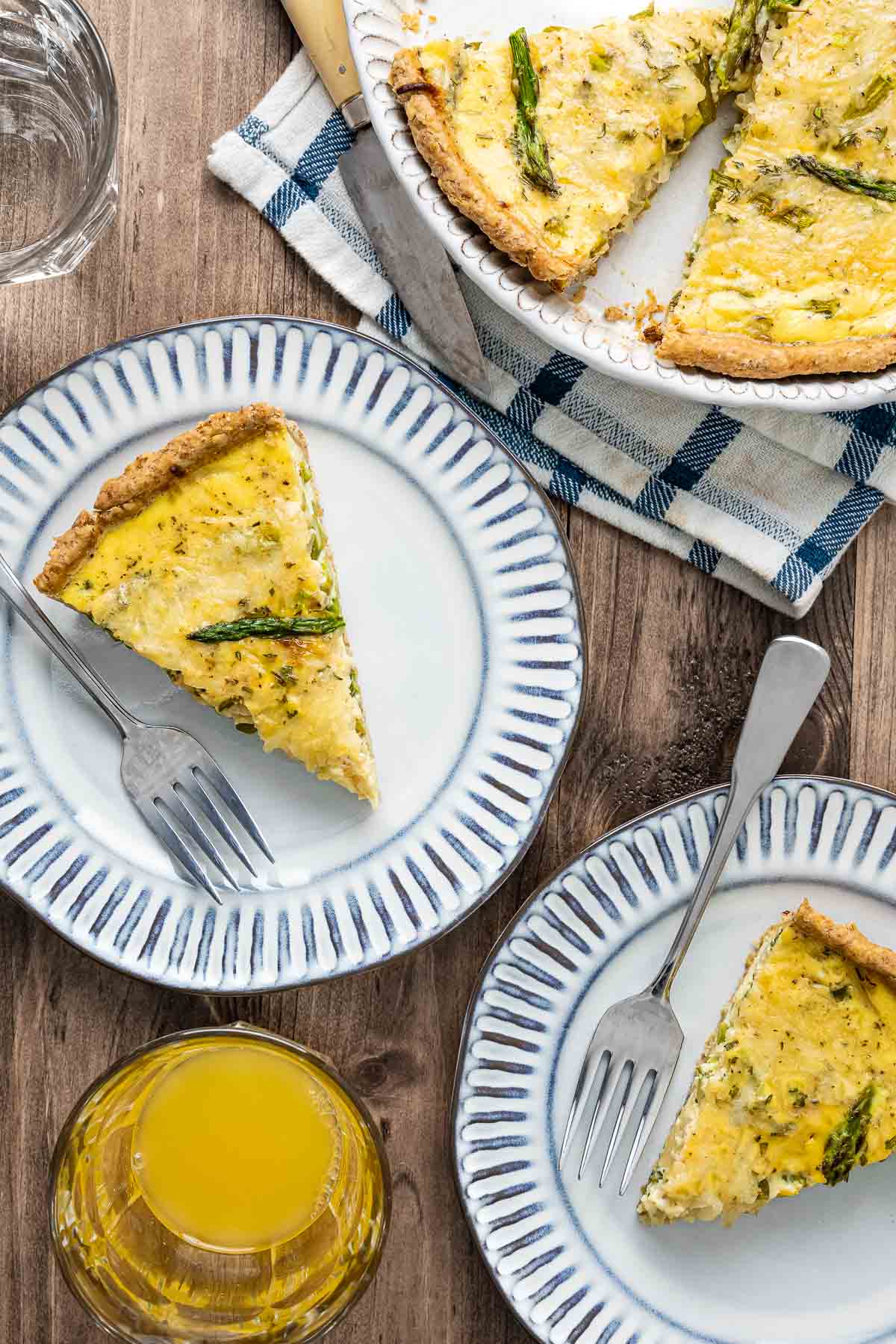
What is Quiche?
Quiche is a French tart made with a savory egg custard baked in a pastry crust. It can be plain, or filled with vegetables, cheese, meat, or seafood.
With a few swaps—like extra virgin olive oil for butter, milk for cream and whole wheat flour for some of the all purpose flour—it’s easy to make a healthy quiche that’s just as delicious as it is wholesome.
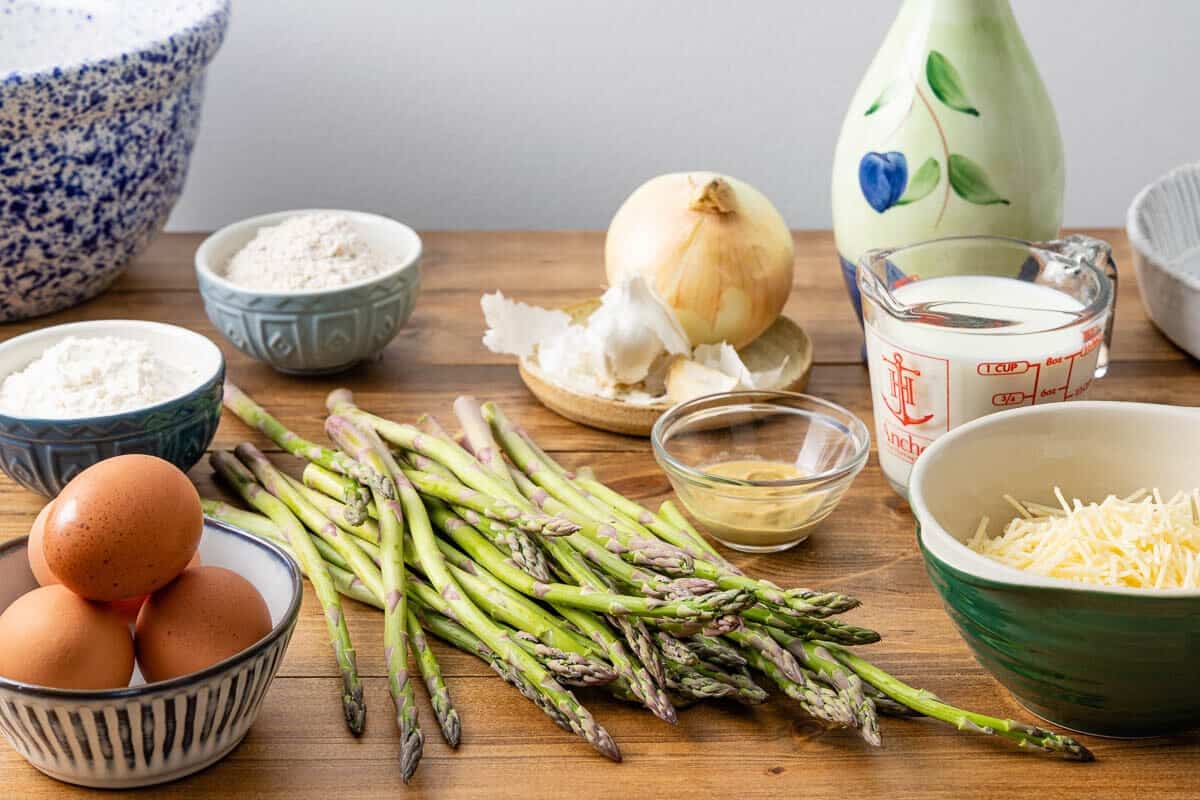
Ingredients Needed to Make Quiche
You can easily find everything you need to make this asparagus quiche recipe at the grocery store. If you’re lucky enough to have a farmers market nearby pick up some freshly-picked asparagus from your favorite farmer.
- Whole wheat flour: I love robust and nutty whole wheat flour, whether I’m making quiche or pizza dough. It provides not only a nutritious boost but a flavorful one too.
- All-purpose flour: A small amount of all–purpose flour prevents the whole wheat dough from being too brittle.
- Kosher salt and freshly ground black pepper: Elevates the flavors of the other ingredients. You can also substitute with coarse sea salt or Himalayan pink salt if desired.
- Extra virgin olive oil: Piquant extra virgin olive oil, like our Nocellara Italian EVOO, is used in the crust in place of butter. Just like butter, olive oil makes a flaky crust and is a harmonious partner to whole-grain flour.
- Onion: Yellow or white onion provides a sweet flavor base for the vegetables.
- Asparagus: A taste of spring, green asparagus is earthy and grassy. Break off the tough ends with a satisfying snap, then cut them into 1-inch pieces.
- Garlic: Garlic and asparagus share savory flavor compounds (Also, it’s no secret that garlic tastes good in almost everything).
- Eggs: Eggs are a high-quality protein with several important vitamins and minerals, such as vitamin B and selenium.
- Reduced fat milk: Feel free to use whole milk for a richer quiche, or fat-free milk for a lighter one. I chose 2 percent reduced-fat milk for a balance of nutrition and flavor.
- Asiago cheese: Asiago cheese has less fat than most cheeses. More importantly, though, it has a sweet, nutty flavor that works well with asparagus. You can also substitute Fontina, Gruyère, Cheddar, or Swiss.
- Dijon mustard: Mustard seed has been used in the Mediterranean for thousands of years. Dijon is complex, sharp, and imparts a lot of flavor to the custard.
- Fresh thyme or tarragon: Floral thyme or lightly licorice-flavored tarragon are natural partners to asparagus and eggs.
- Pie weights or dried beans: Used to weigh down the crust as it bakes. The weight prevents the dough from puffing or shrinking. If you don’t have pie weights, you can use rice, or break into your penny collection.
How to Pick the Freshest Asparagus: Tips & Tricks
Peak asparagus season in the Northern Hemisphere is typically spring, from April to early June. The asparagus becomes sweet, tender, and full of flavor. Here are a few indicators of the freshest asparagus to look out for at your grocery store or farmers market.
- Stalk size: Small to medium-sized stalks are easy to find at the grocery store. They’ll cook more quickly than the thicker spears you might find at your local farmers market. The size of an asparagus stalk depends mostly on age, nutrition, and when stalks are harvested. Both thick or thin stalks are great in this recipe. If your spears are on the thicker side, cut them in half horizontally before sauteing them. Both thick and thin spears can be woody so it’s best to check and snap or trim the ends.
- The bend and snap: Check to see that the stalks are firm and threaten to snap when you bend them. Make sure none of the tips are slimy, which is an indication that the asparagus is past its prime.
- Store asparagus properly: If you’re buying the asparagus a few days ahead of cooking, trim the ends. Store in the fridge, standing in a glass with an inch or two of water like you would with flowers.
How to Make Asparagus Quiche
If you’re planning to make a serve the quiche all in one day, plan on starting this recipe about 2 1/2 to 3 hours before you plan to serve it.
However, if you’re partial to making recipes in stages, prepare the crust a day or two ahead of time. Then wrap it tightly in plastic and store it in the refrigerator. Finally, if you just want to make the whole thing the night before go for it. Just warm it up in a 350°F oven for about 15 minutes before serving.
- Make the dough: Add the all-purpose flour, whole wheat flour, and salt into the bowl of a food processor. Pulse a few times to mix. Next, pour in the olive oil and pulse until it’s evenly distributed. Add the water and pulse until the mixture begins to clump and is evenly moistened.
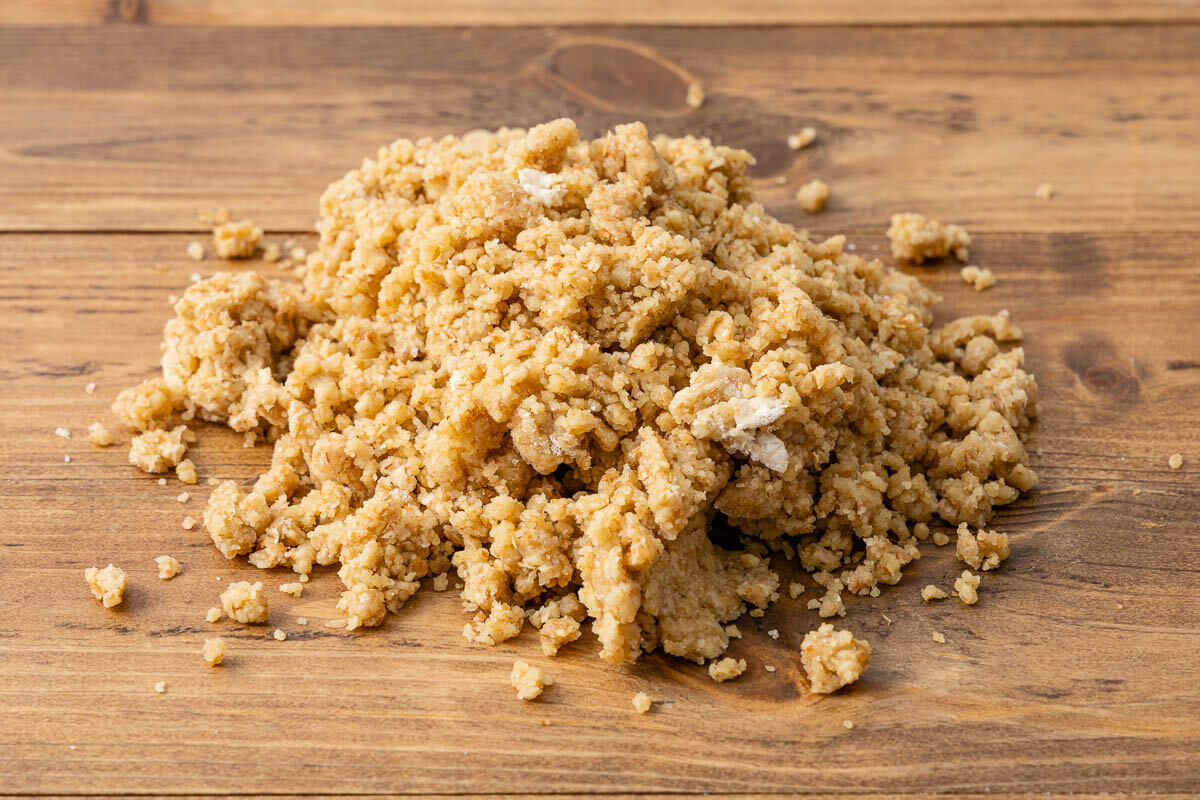
- Knead and shape the dough: Turn the dough onto a lightly floured work surface. Gently knead by hand until the dough comes together into a ball. Press the dough into a disk, about 1-inch thick. Wrap the disk in plastic and let it rest at room temperature for 1 hour. This resting period gives the flour time to hydrate and the gluten to relax.
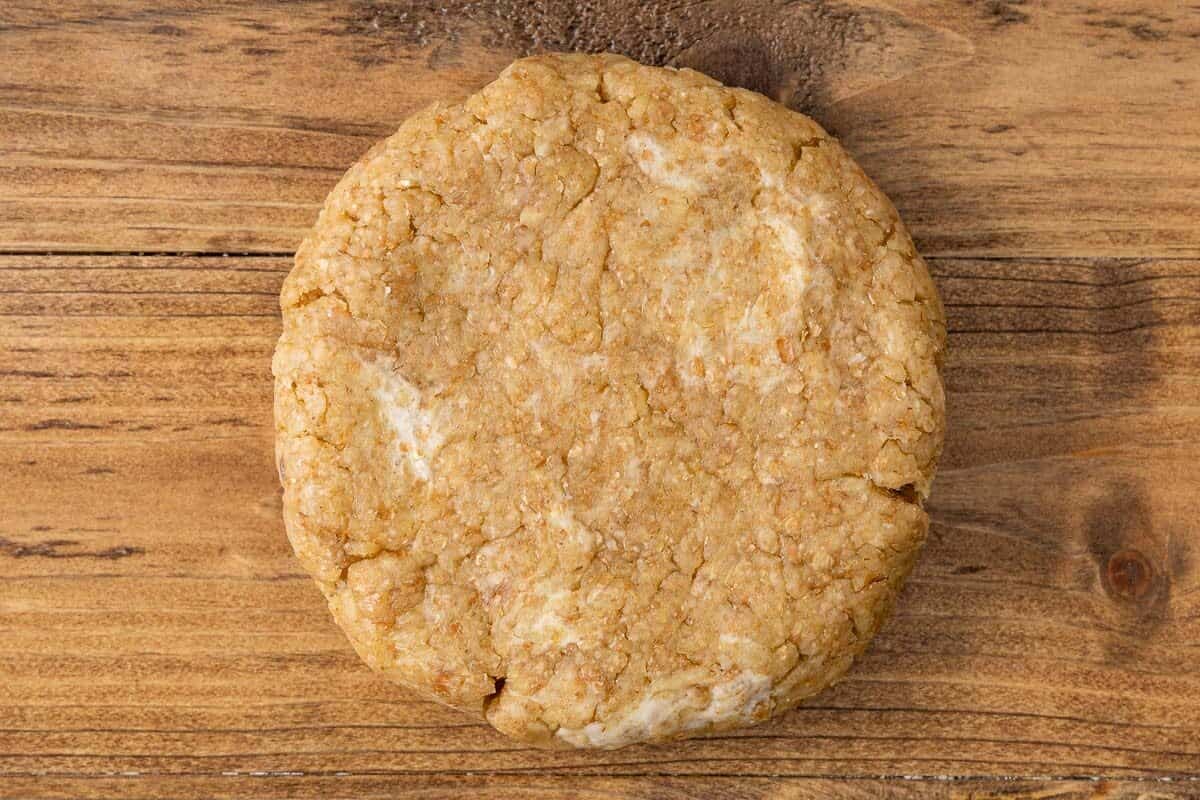
- Get ready to bake: Arrange a rack in the center of the oven and preheat to 375°F. Dust your countertop lightly with flour. Use a rolling pin to roll out the dough to an 11-inch circle, about 1/8-inch thick.
- Transfer the dough: Carefully transfer the dough into a 9-inch pie dish. Roll the dough around the rolling pin and unroll it it into the pie plate. Gently press in the dough to line the pie dish. Roll and fold the overhang of dough to build up the edges. Trim excess dough as you work around the circumference of the pie dish. Use your fingers or a fork to crimp the edges, or leave them be for a more rustic finish.
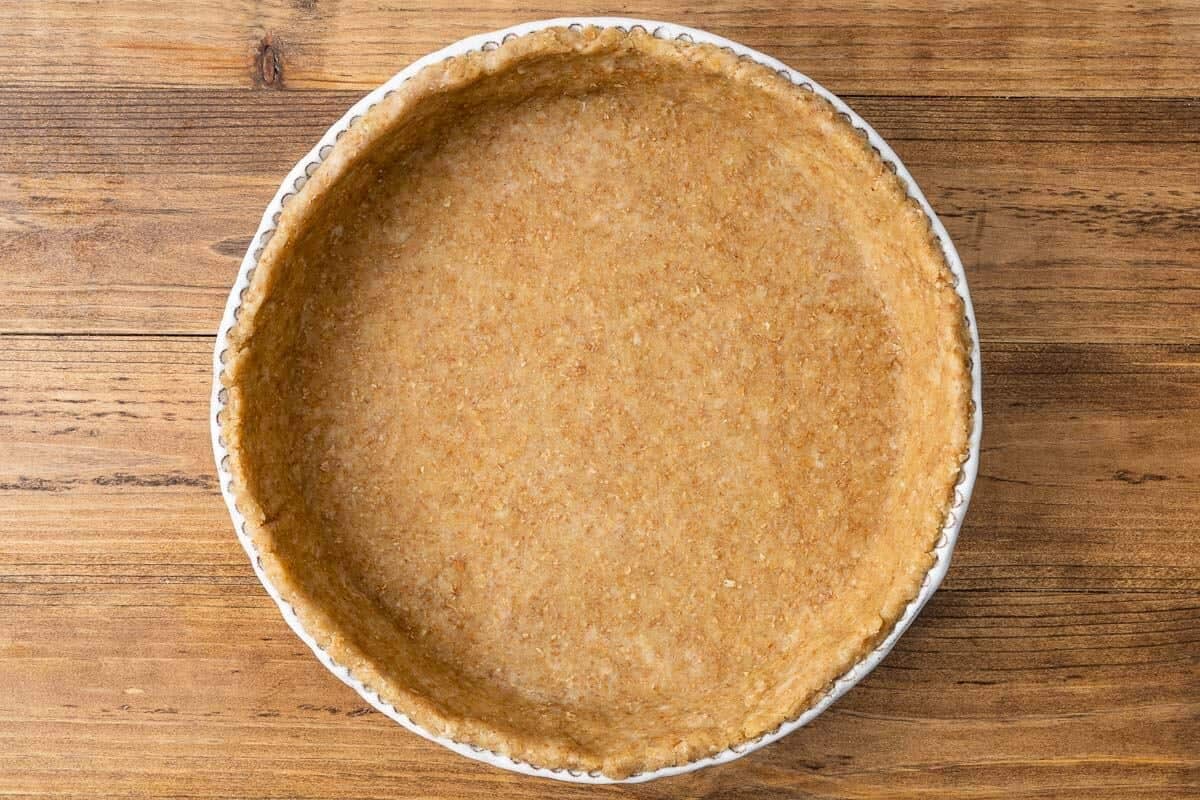
- Blind bake the crust: Cover the crust with parchment paper. Then fill with pie weights or dried beans and bake for 20 minutes. Remove the parchment and pie weights then return the pie crust to the oven and bake for an additional 10 minutes. Tip: This is called parbaking, and a parbaked crust can be made ahead. Cool and store in an airtight or in a zip-top bag at room temperature for up to 3 days.
- Cook the vegetables: In a large nonstick skillet set over medium heat, add the oil. Add the sliced onions and cook, stirring occasionally with a wooden spoon, until translucent and softened, about 5 min. Add the asparagus and cook until tender and bright green, another 5 minutes. Stir in the minced garlic and cook for 1 minute until fragrant. Remove from the heat and slide the vegetables into the blind-baked crust. Top with the grated cheese.
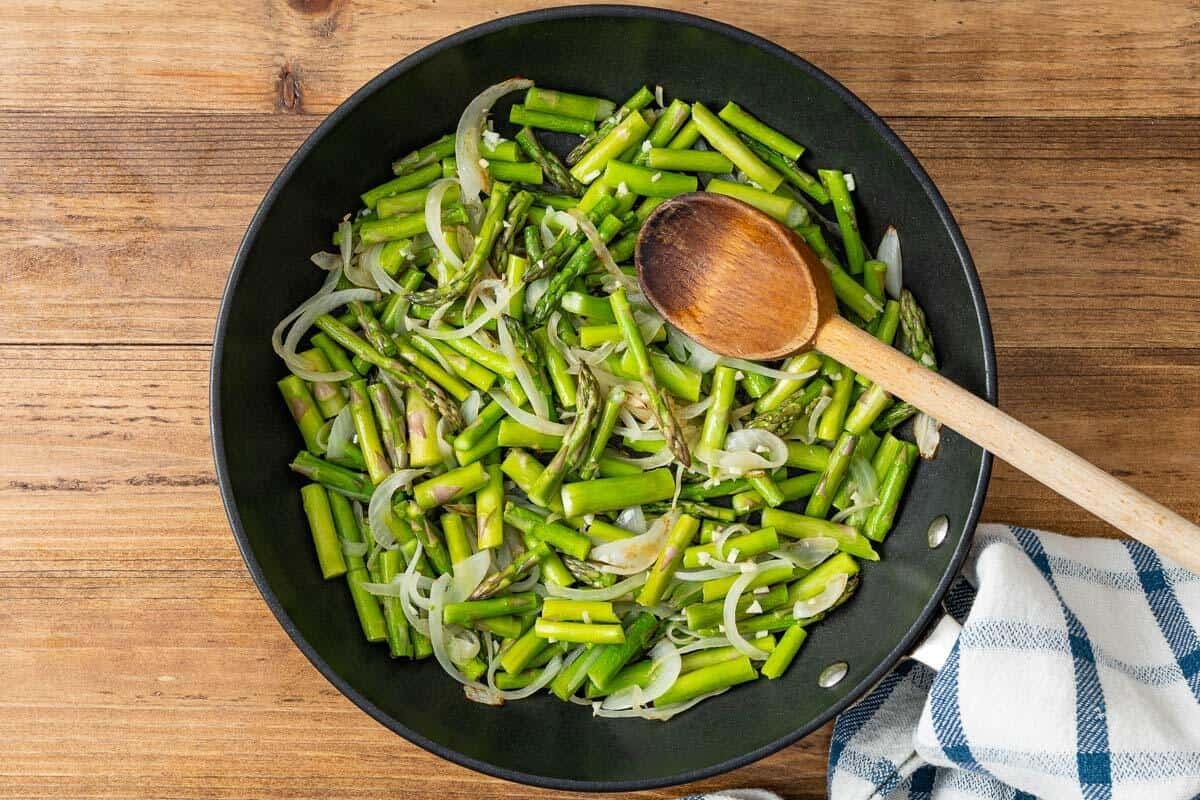
- Prepare the custard: In a large mixing bowl, whisk together the eggs, milk, Dijon mustard, and herbs (if using). Once fully combined, pour the egg mixture into the crust, stopping 1/4-inch from the top. You may not use all of the egg mixture, depending on the depth of your pie pan.
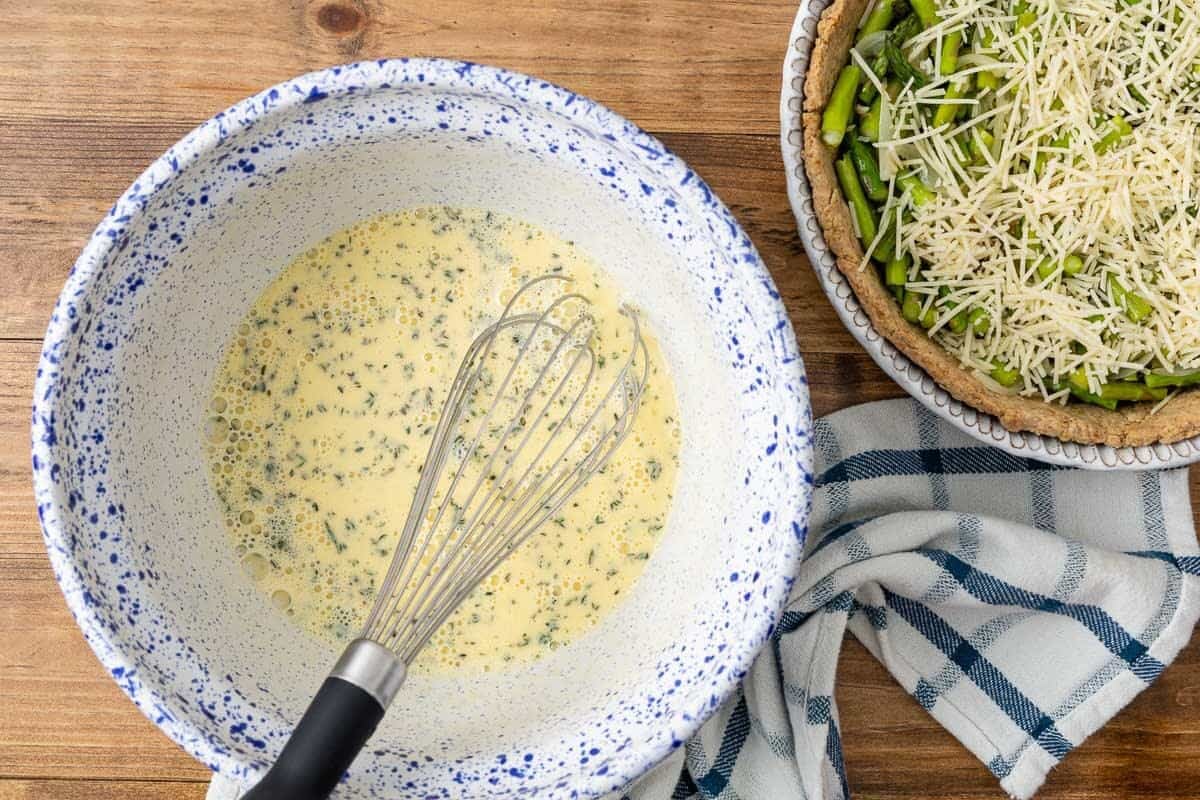
- Bake and serve: You can either set the pie plate directly into your oven or put it on a baking sheet to help prevent spills, then transfer it to the oven. It’s up to you. Bake until the edges are set but the center still jiggles just a little, 30-35 minutes. Once set, remove the quiche from the oven and cool for at least 15 minutes before slicing and serving. Serve warm, at room temperature, or cold.
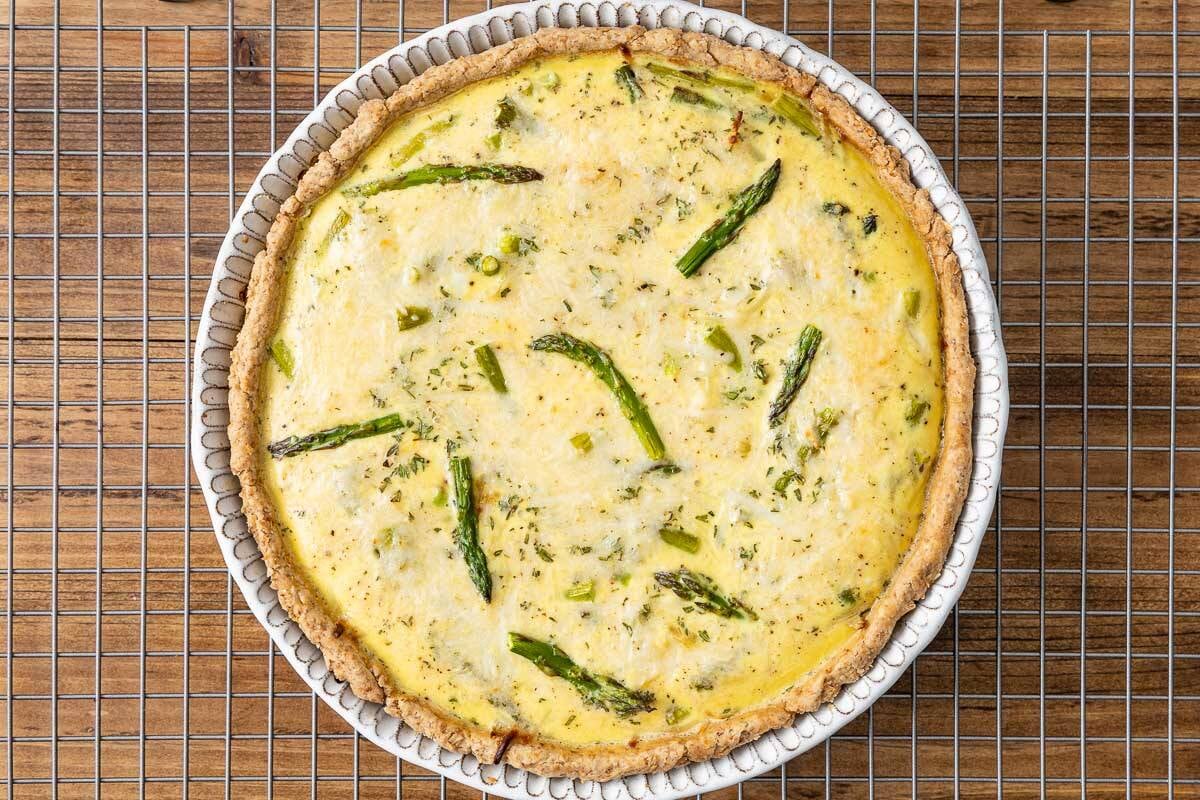
Variations of Asparagus Quiche
This asparagus quiche recipe is easy to tailor to your taste and dietary needs. Simply swap the vegetables, crust, milk, or seasonings.
- Swap out the asparagus. Use another wholesome green vegetable, like spinach, broccoli, broccolini, or broccoli rabe to complement the flavors in this quiche.
- Make it gluten-free. Use your favorite gluten-free pie crust recipe, or make it crustless. For a crustless quiche, grease the pie plate with a little olive oil to prevent sticking. Then, skip the crust and bake as written.
- Make it dairy-free. Use your favorite unflavored plant-based milk and leave out the cheese.
- Save time with frozen pie crust. Nowadays there are plenty of frozen pie crusts to choose from that are whole grain or gluten-free. See the package instructions for whether and how to par-bake the crust.
How to Store Quiche
After cooling, cover the quiche and store it in the refrigerator for up to 4 days. To make it ahead, bake it the day before and reheat at 350°F for 15 minutes, or until warmed through.
Leftover slices can be frozen for up to 1 month. Freeze fully cooled slices on a tray in a single layer for 2 to 3 hours. Once frozen solid, transfer the slices to a freezer-safe reusable container or freezer bag.
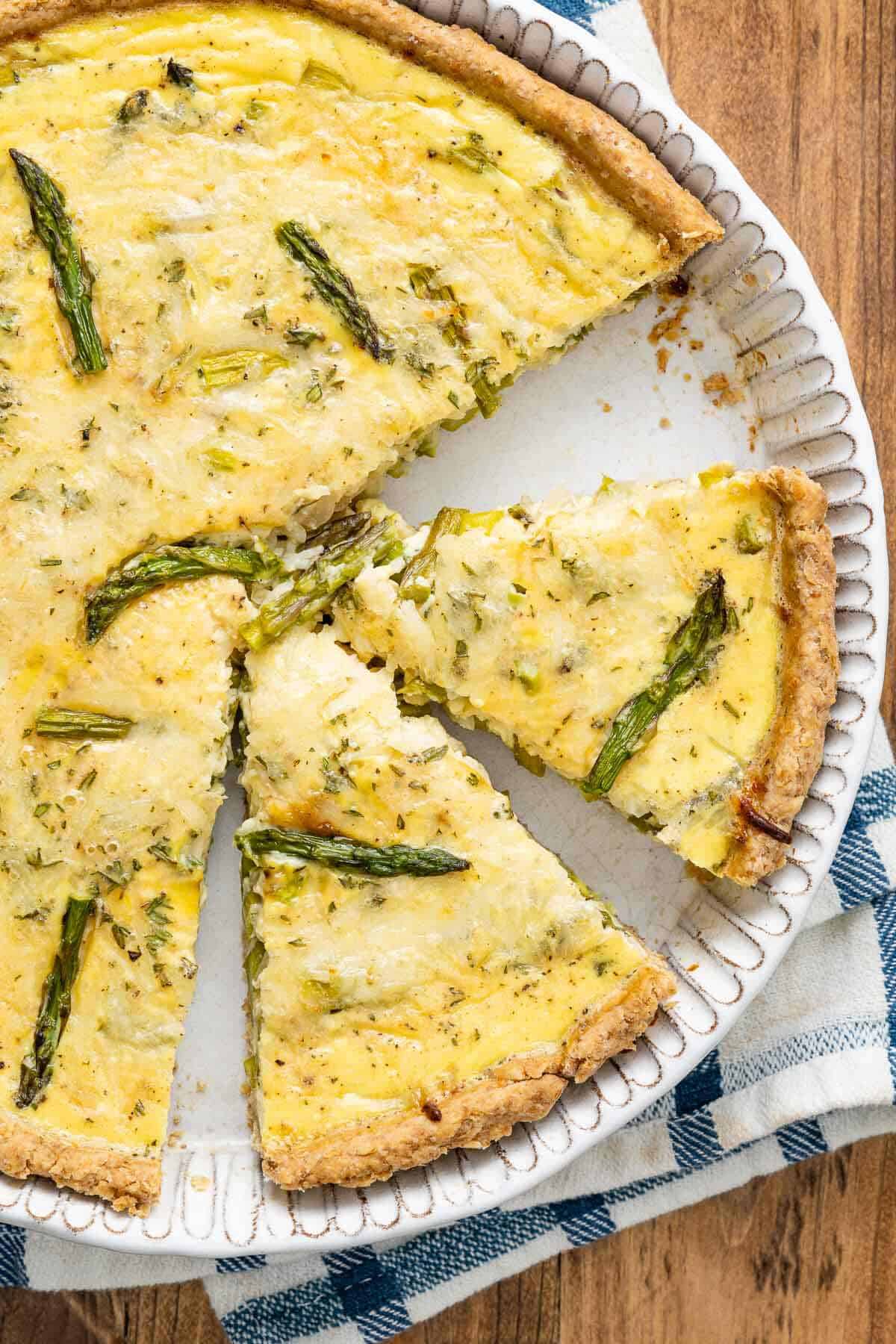
What to Serve with Asparagus Quiche
Serve asparagus quiche warm, room temperature, or cold. Add a side of crisp salad greens and a glass of freshly squeezed orange juice for a light lunch.
For a brunch spread, serve with Mashed Potato Pancakes, a bright and citrusy fruit salad and a pitcher of White or Red Wine Sangria. It’s always nice to have something sweet like blueberry muffins or this Healthy Carrot Cake to round out the meal.
More Brunch Recipes We Love
Browse all Mediterranean recipes.
Visit Our Shop.
Bundle and Save!
Four of our best-selling signature olive oils. The Everyday EVOO Bundle is perfect for everyday use.
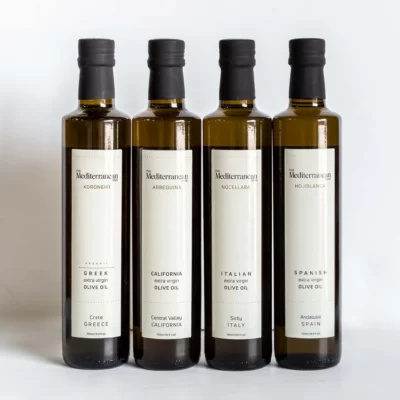
Healthy Asparagus Quiche
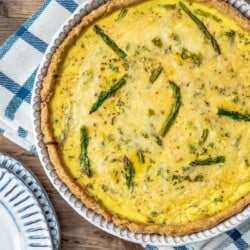
Ingredients
For the dough:
- 3/4 cup 90 g all-purpose flour, plus more for dusting
- 3/4 cup (85g) whole wheat flour
- 1/2 teaspoon kosher salt
- 1/4 cup extra virgin olive oil
- 1/4 cup water
For the filling:
- 1 teaspoon extra virgin olive oil
- 1/2 onion thinly sliced
- 12 ounces asparagus, cut into 1-inch pieces
- 1 garlic clove, minced
- 1/2 cup grated Asiago cheese (56g)
- 4 large eggs
- 1 cup 2% milk
- 1 tablespoon Dijon mustard
- 1 teaspoon chopped fresh thyme or tarragon leaves (optional)
- 1/2 teaspoon kosher salt, divided
- 1/8 teaspoon freshly ground black pepper
Instructions
- Make the dough: Add the all-purpose flour, whole wheat flour, and salt into the bowl of a food processor and pulse a few times to mix. Pour in the olive oil and pulse until evenly it’s distributed through the flour. Add the water and pulse until the mixture begins to clump and is evenly moistened.
- Knead the dough: Turn the dough onto a lightly floured work surface and lightly knead by hand until the dough comes together into a ball. Press the dough into a disk, about 1 inch thick. Wrap the disk in plastic and let it rest at room temperature for 1 hour. This resting period gives the flour time to hydrate and the gluten to relax.
- Get ready to bake: Arrange a rack in the center of the oven and preheat to 375°F. Dust your countertop lightly with flour. Use a floured rolling pin to roll out the dough to an 11-inch circle, about 1/8-inch thick.
- Transfer the dough: Carefully transfer the dough into a 9-inch pie dish by rolling the dough around the rolling pin and unrolling it into the pie plate. Gently press in the dough to line the pie dish. Roll and fold the overhang of dough to build up the edges, trimming excess dough as you work around the circumference of the pie dish. Use your fingers or a fork to crimp the edges, or leave them be for a more rustic finish.
- Blind bake the crust: Cover the crust with parchment paper or tin foil. Fill with pie weights or dried beans and bake for 20 minutes. Remove the parchment and pie weights and bake for 10 minutes.
- Cook the vegetables: While the crust bakes, heat 1 teaspoon of olive oil in a large nonstick skillet over medium heat. Add the onions and cook, stirring occasionally with a wooden spoon, until translucent and softened, about 5 min. Add the asparagus and cook until tender and bright green, another 5 minutes. Stir in the garlic and cook for 1 minute until fragrant. Remove from the heat and slide the vegetables into the blind-baked crust. Top with the grated cheese.
- Make the egg filling: In a large mixing bowl, whisk together the eggs, milk, Dijon mustard, herbs (if using), 1/2 teaspoon salt, and 1/8 teaspoon pepper. Pour the egg mixture into the crust, stopping 1/4 inch from the top. You may not use all of it, depending on the depth of your pie pan.
- Bake, cool, slice, and serve: Bake the quiche for 30-35 minutes, or until the edges are set but the center still jiggles just a little.Remove the quiche from the oven, and cool for at least 15 minutes before slicing and serving. Serve warm, at room temperature, or cold.
Notes
- Make sure you have something to weigh the crust as it blind bakes, like dried beans, rice, pie weights, or clean pennies.
- To trim the asparagus, hold the bottom of the stalk with one hand and the middle with the other. Bend until it snaps (it will naturally break where the tender and woody parts meet).
- Visit our shop to browse quality Mediterranean ingredients including olive oils, honey, jams and spices.
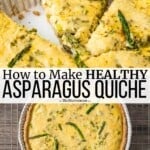


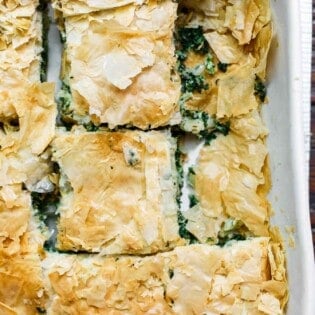
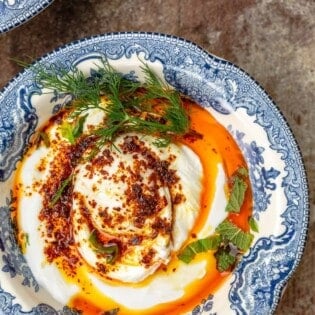
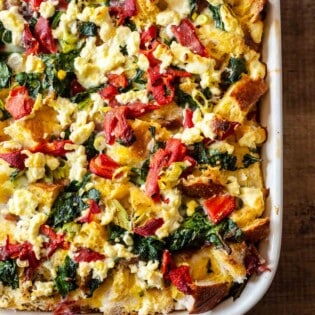
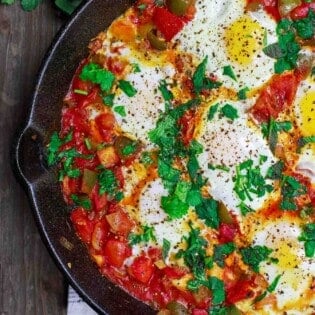
Made this twice already. It’s a very good, light quiche. I used an organic frozen pie crust which I prebaked for 10 minutes before adding the filling. It needs to cook longer than 35 minutes. I suggest about 45 minutes which, in my oven, delivered a more firm filling and a lovely golden crust.
Planning to make the recipe for brunch with friends this weekend. Other than the lower fat content, is there any reason to use 2% milk versus whole milk?
Hi, Pat. Nope! Really milk will work. Mark just chose 2 percent reduced-fat milk here for a balance of nutrition and flavor.
Very tasty. I had to use a little more olive oil for my crust to become a dough. The flavors come together nicely. Will be making this again and again.
Thanks so much, Kristen!
What gluten free options would you use? My daughter in law has Celiac.
Hi, Kristi! I’m Summer and I work here at The Mediterranean Dish. We actually have two crustless quiche recipes that are gluten-free — spinach mushroom crustless quiche and a crustless zucchini quiche. Frittatas are a great option for as well for those who are gluten-free. Just search frittatas on the website and you will find a few different kinds. Good luck.
Hi, Kristi. This is Kate. I work here at The Mediterranean Dish and also have celiac disease. I have tried this recipe with a frozen gluten free pie crust, and it’s delicious! Bob’s Red Mill brand also makes an amazing pie crust mix that would likely work here, as well.
Yes, real men do eat quiche. I love it. However, I prefer it without a crust. I like to moisten the pan with EVOO and sprinkle in panko bread crumbs. Pour out any not adhering and you’re on your way. Easy-peasy.
I used a ready made Walnut crust from the pie shell aisle, made by Diamond. Excellent substitute
Can I make this crustless ?
Hi, Mitzi. We have not tested this recipe without the crust, but I feel like it would work. Suzy has a crustless zucchini quiche recipe you can use as a guide, if you want to give it a try.
Perfect, perfect, perfect! I made this for my family for brunch and it was a hit. My family likes quiche anyway but I added kielbasa and mushrooms which put it over the top.
I appreciate that you concentrated on a more healthy alternative as I didn’t have to use any butter. Thanks for sharing this recipe!
Our pleasure, Diane! Thank you for taking the time to comment!
Love this quiche. Made it for Easter breakfast for tomorrow & will make it again & again! Thank you!
Awesome! Thanks, Mary Jo!
This was very good.
My crust dough did not end up anywhere close to being rollable. I added some extra olive oil and extra water but it never formed a dough. I ended up pressing it into the pie pan like you would a graham cracker crust.
Followed all other directions as written. I was a little worried about how crumbly it still looked after blind baking, but happy to report that I think the moisture from the egg mixture helped it.
Final result was a solid crust. Taste was great!
Thanks for the feedback, Jenny! Glad it worked out okay in the end :).
When I prebake crust I get bubbles that prevent crust from nice form on bottom. Are we supposed to poke with fork before baking? Why is this not mentioned. I feel like it would have helped, or am I doing something else wrong. Thanks!
Hi, Beth. Filling the pie with weights or dried beans, as suggested, should be enough to keep the crust down during the blind baking process. Make sure you have enough weights to fill the crust to the top. If you want, as an extra layer of caution, you can dock the crust with a fork before adding the weights, but it shouldn’t be necessary.
How to make this dairy free
I am looking forward to you reply
Hi, Satya! You could just reduce the amount of milk by half and replace the amount you do use with an unsweetened plant-based milk and leave out the cheese. You might also like this recipe which doesn’t have any dairy in it https://www.themediterraneandish.com/middle-eastern-zucchini-baked-omelet-eggah/ if you leave out the cheese. Good luck.
Can this be made crustless?
Hi, Arianna! I’m Summer, an editor here at The Mediterranean Dish. You certainly can make this crustless. Just make sure you brush the pie plate with olive oil before adding the filling. Bake it for the same amount of time as the recipe states, but start checking it about 10 minutes before the finish time.
Can you make this crustless?
I’m Summer, an editor here at The Mediterranean Dish. You certainly can make this crustless. Just make sure you brush the pie plate with olive oil before adding the filling. Bake it for the same amount of time as the recipe states, but start checking it about 10 minutes before the finish time.
Hi Suzy, I’m trying to make the dough for the healthy asparagus quiche.l followed the recipe but it doesn’t seem to clump and it’s still too powdery to form into a ball. What am I doing wrong???
Hi, Tom! I’m Summer. I work with Suzy here at The Mediterranean Dish. Pie crusts with whole wheat flour can be kind of tricky. You may need to just work with a little longer to bring it together. The dough will continue to hydrate after you’ve wrapped it and it sits for a while. However, you can also spray it with just a touch of water if you really feel like it needs more moisture to come together. If all else fails opt for crustless quiche and just brush the pie crust with olive oil and add the filling, then bake. I hope this helps.
Sounds wonderful! Can I use ready-made pie crusts?
Hi, Patti! I’m Summer an editor here at The Mediterranean Dish. You certainly can use ready-made pie crust if you prefer. Enjoy!
I really appreciate you providing substitutes for gluten-free and dairy-free! I’ll be giving this recipe a go with the suggested subtitutes for my Easter Brunch! Thank you!
So glad you found that helpful, Amy! Hope everyone enjoys the quiche!